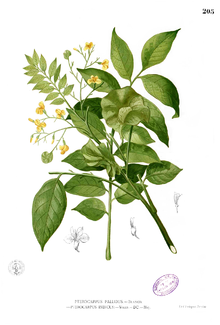Our website is made possible by displaying online advertisements to our visitors.
Please consider supporting us by disabling your ad blocker.
Pterocarpus indicus
| Pterocarpus indicus | |
|---|---|

| |
| Scientific classification | |
| Kingdom: | Plantae |
| Clade: | Tracheophytes |
| Clade: | Angiosperms |
| Clade: | Eudicots |
| Clade: | Rosids |
| Order: | Fabales |
| Family: | Fabaceae |
| Subfamily: | Faboideae |
| Genus: | Pterocarpus |
| Species: | P. indicus
|
| Binomial name | |
| Pterocarpus indicus | |
| Synonyms[2] | |
|
List
| |
Pterocarpus indicus (commonly known as Amboyna wood, Malay padauk, Papua New Guinea rosewood, Philippine mahogany, Andaman redwood, Burmese rosewood, narra[3] (from Tagalog[4]) and asana in the Philippines, angsana, or Pashu padauk) is a species of Pterocarpus of the Sweet Pea Family (Papilionaceae) native to southeastern Asia, northern Australasia, and the western Pacific Ocean islands, in Cambodia, southernmost China, East Timor, Indonesia, Malaysia,[5] Papua New Guinea, the Philippines, the Ryukyu Islands, the Solomon Islands, Thailand, and Vietnam.[6]
Pterocarpus indicus was one of two species (the other being Eysenhardtia polystachya) used as a source for the 16th- to 18th-century traditional diuretic known as lignum nephriticum.[7]
Many populations of Pterocarpus indicus are seriously threatened. It is extinct in Vietnam and possibly in Sri Lanka and Peninsular Malaysia.[1] It was declared the national tree of the Philippines in 1934 by Governor-General Frank Murphy of the Insular Government of the Philippine Islands through Proclamation No. 652.[8]
- ^ a b Barstow, M. (2018). "Pterocarpus indicus". IUCN Red List of Threatened Species. 2018: e.T33241A2835450. doi:10.2305/IUCN.UK.2018-2.RLTS.T33241A2835450.en. Retrieved 19 November 2021.
- ^ "Pterocarpus indicus Willd". The World Flora Online. World Flora Consortium. 2023. Retrieved 18 October 2023.
- ^ "Pterocarpus indicus". Germplasm Resources Information Network. Agricultural Research Service, United States Department of Agriculture. Retrieved 6 July 2017.
- ^ Merrill, Elmer Drew (1903). A dictionary of the plant names of the Philippine Islands. Manila: Bureau of Public Printing, Department of The Interior. p. 179 – via University of Michigan Digital Collections.
- ^ Gardner, Simon; Sidisunthorn, Pindar; Ee, Lai (2011). Heritage Trees of Penang. George Town, Penang, Malaysia: Areca Books. ISBN 978-967-57190-6-6. [page needed]
- ^ "Pterocarpus indicus". International Legume Database & Information Service. Archived from the original on 8 June 2011.
- ^ Muyskens, M.; Ed Vitz (2006). "The Fluorescence of Lignum nephriticum: A Flash Back to the Past and a Simple Demonstration of Natural Substance Fluorescence". Journal of Chemical Education. 83 (5): 765. Bibcode:2006JChEd..83..765M. doi:10.1021/ed083p765.
- ^ Pangilinan, Leon Jr. (3 October 2014). "In Focus: 9 Facts You May Not Know About Philippine National Symbols". National Commission for Culture and the Arts. Archived from the original on 26 November 2016. Retrieved 8 January 2019.
Previous Page Next Page



